 Technology
Technology  Technology
Technology  Humans
Humans 10 Everyday Human Behaviors That Are Actually Survival Instincts
 Animals
Animals 10 Animals That Humiliated and Harmed Historical Leaders
 History
History 10 Most Influential Protests in Modern History
 Creepy
Creepy 10 More Representations of Death from Myth, Legend, and Folktale
 Technology
Technology 10 Scientific Breakthroughs of 2025 That’ll Change Everything
 Our World
Our World 10 Ways Icelandic Culture Makes Other Countries Look Boring
 Misconceptions
Misconceptions 10 Common Misconceptions About the Victorian Era
 Mysteries
Mysteries 10 Strange Unexplained Mysteries of 2025
 Miscellaneous
Miscellaneous 10 of History’s Most Bell-Ringing Finishing Moves
 Technology
Technology Top 10 Everyday Tech Buzzwords That Hide a Darker Past
 Humans
Humans 10 Everyday Human Behaviors That Are Actually Survival Instincts
 Animals
Animals 10 Animals That Humiliated and Harmed Historical Leaders
Who's Behind Listverse?

Jamie Frater
Head Editor
Jamie founded Listverse due to an insatiable desire to share fascinating, obscure, and bizarre facts. He has been a guest speaker on numerous national radio and television stations and is a five time published author.
More About Us History
History 10 Most Influential Protests in Modern History
 Creepy
Creepy 10 More Representations of Death from Myth, Legend, and Folktale
 Technology
Technology 10 Scientific Breakthroughs of 2025 That’ll Change Everything
 Our World
Our World 10 Ways Icelandic Culture Makes Other Countries Look Boring
 Misconceptions
Misconceptions 10 Common Misconceptions About the Victorian Era
 Mysteries
Mysteries 10 Strange Unexplained Mysteries of 2025
 Miscellaneous
Miscellaneous 10 of History’s Most Bell-Ringing Finishing Moves
10 Incredible Stories About The Real-Life Sherlock Holmes
Ever since he showed up in A Study in Scarlet, Sherlock Holmes has fascinated readers with his powers of deduction and arrogant eccentricities. But is this iconic investigator purely fictional, or was he based on a real-life hero?
Die-hard fans probably know the answer already. According to Sir Arthur Conan Doyle, Holmes is a combination of Joseph Bell and Henry Littlejohn, both skilled doctors who assisted police and possessed the amazing ability to size up a person with a single glance. But while they influenced Doyle’s detective, they didn’t actually investigate crimes or battle any British baddies.
Jerome Caminada, on the other hand, was Sherlock Holmes in the flesh. While historians debate if he actually inspired Doyle’s classic character, this Victorian investigator was definitely England’s number one super sleuth. Both brainy and brawny, Caminada traveled all across the UK to catch the realm’s most conniving crooks, and his adventures rival the plot of any Sherlock story.
10 The Garibaldi Of Detectives
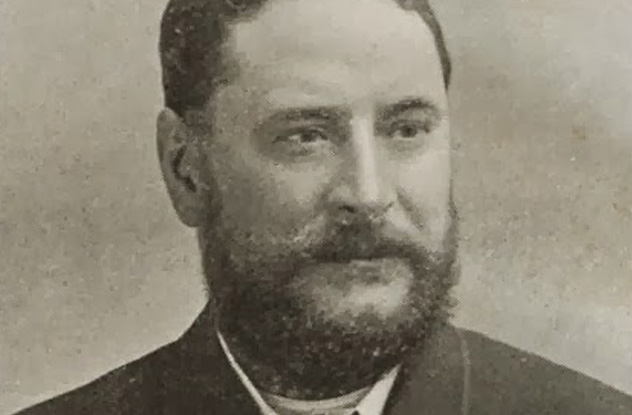
The 19th-century European Giuseppe Garibaldi was a master of guerilla warfare, fought in revolutions across two continents, and is considered one of the founders of modern Italy. To newspapers of the day, Jerome Caminada was known as the “Garibaldi of Detectives.” To the criminal underworld, he was the “terror to evildoers.”
Born in 1844 to immigrant parents, Caminada had a rough life growing up. In addition to losing both his brother and father, he grew up in a neighborhood affectionately known as “Devil’s Gate,” one of the worst slums in Manchester. Caminada was surrounded by brothels, underground saloons, and criminals from every walk of life. Fortunately for law-abiding citizens everywhere, he put his background to good use when he joined the police force and became Manchester’s first Detective Superintendent.
But Caminada wasn’t your run-of-the-mill detective. Instead, his exploits sound like they were ripped straight from the pages of a penny dreadful. When tracking down crooks or hunting for clues, Caminada often disguised himself as a drunk or a common worker and hung out in streets and bars to gather information. His costumes were so impressive that he once fooled his own chief constable.
In addition to his vast array of disguises, Caminada had a network of spies working across Manchester, and he’d often meet his sources in the back of a church. And when Caminada wasn’t looking for clues, he could be found visiting prisons and studying the ways criminals moved and talked. The detective was a big believer in the power of observation, and his skilled eyes would come in quite handy later on.
9 Cleaning Up The Streets

Despite his slender frame, Sherlock Holmes wasn’t a man you wanted to mess with. Over the course of Sir Arthur Conan Doyle’s stories, readers discovered that Sherlock was a practicing martial artist, was strong enough to bend a steel poker, and knew how to throw a pretty good punch. His real-life counterpart was no slouch when it came to laying down the law, either. Even though he wasn’t a big guy, Caminada could more than hold his own in a fight.
In 1874, a reporter for the Manchester Evening News went undercover in the city’s slums, gathering material for a 10-part series on Manchester’s criminal element. Over the course of his investigation, he encountered thieves and prostitutes and even attended the wake of a famous pickpocket, but his most exciting story took place one cold Saturday night when he ran across two people slugging it out in the streets.
What had started as a private brawl—punching, hair pulling, the works—erupted into a massive street fight with spectators taking on spectators in a bloody battle royale. That’s when Caminada strolled straight into the fray, cool as ice and without any weapons. In the words of the reporter, “He was of average build, but broadly set, and he ‘went for’ the crowd instantly with a quiet determination.”
His first move was to separate the instigators. He shoved one woman into the mob and hurled the other inside a house. Next, Caminada turned to the men and ordered them to “be off.” One lowlife decided to get tough and threatened the detective instead. The punk found himself “seized by the collar, run barrow-fashion down the street, shoved into his own residence, and told to remain inside.” The rest of the men quickly dispersed.
8 Womanizing Ways

Anyone here a fan of Steven Moffat’s modern-day Sherlock TV show? If so, you’ll no doubt remember the episode where Sherlock finds some sensitive documents on behalf of a client by pledging his undying love to a secretary. Sure, toying with someone’s affections isn’t terribly considerate, but when you’re a detective, you don’t have time to play nice.
And it isn’t just Benedict Cumberbatch who’s charmed his way into solving a case. Jerome Caminada was quite the flirt as well and had no qualms about manipulating women to catch a crook. On numerous occasions, he took ladies to the park or perhaps out on a boat in order to ply them for information.
During one investigation, Caminada was trying to find a fraudulent businessman on the lam. Figuring his servants might know his whereabouts, Caminada hired a band to play music outside his house. When the maids came out to listen, the detective was able to interrogate each one.
The case was solved when Caminada took one of the maids to Leeds and even spent a bit of cash to buy her a fancy umbrella. Quite smitten, the maid gave up her employer’s location, and after Caminada got his man, he sent the poor girl a letter claiming he’d died.
7 Tracking Down Female Swindlers

Her name was Alicia Ormonde, though sometimes she was known as Mrs. Frost, Miss Morley, or Mrs. Baird. Occasionally, she was a married woman, other times a widow in need of assistance, and sometimes the “romantic maiden who would be shocked to go out walking or riding with any male friend.” Beautiful and well educated, she claimed she was related to aristocratic nobles, but she frequently found herself in need of cash. And what money lender could deny such a respectable, attractive lady?
Caminada described this comely con artist as “one of those syrens (sic) who never deceive a man without robbing him.” One of her scams involved asking a lender for a large amount of cash, claiming she’d lost all her money to a hustler. When asked for security, she provided a phony will and gave the lender a lien on her imaginary inheritance. When the duped businessman asked to double-check everything with her attorney, Ormonde provided the name of a real lawyer but gave a fake address. That way, she’d receive all the letters and give herself a strong recommendation.
By the time Caminada caught up with Ormonde in 1890, she’d already swindled countless lenders. Strangely enough, he had trouble getting anyone to testify against Miss Ormonde as the men were too embarrassed to admit they’d been fooled. But, eventually, Caminada proved his case, and Ormonde was sentenced to 12 months behind bars. Chances are good the detective felt a pang of regret as he supposedly had become infatuated with his female foe.
Ormonde wasn’t the only woman Camainada tracked down, though. Elizabeth Burch was a middle-aged dressmaker who’d inherited £150,000 after helping a rich, old gentleman who’d collapsed in the street. With her money coming any day, she moved from South Kensington to Ashford, where she started living the good life. However, Burch wasn’t selfish. She wanted to help others who were down on their luck by writing extremely emotional letters on behalf of needy charities. Of course, there was no £150,000, and Miss Burch was keeping all those charitable donations for herself.
When things got too hot in Ashford, she packed up, renamed herself “Lady Russell,” and moved to Manchester, which was a big mistake. When she showed up, she immediately attracted the attention of eagle-eyed Caminada. Smelling a Victorian rat, the detective visited the newly arrived socialite and found documents in her home linking her to multiple scams. Thanks to his work, the Ashford Heiress spent six months in prison where, oddly enough, she took up writing fiction.
6 The Bogus Doctor
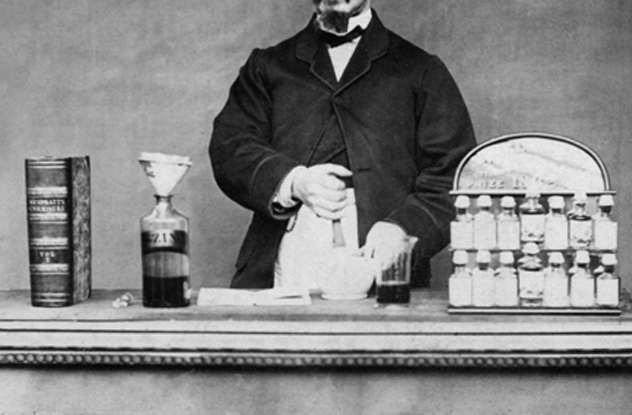
The Rev. E.J. Silverton wasn’t exactly a model of virtue and honesty. Working out of Nottingham, this protestant physician claimed he could cure all diseases, even deafness, with his own home brewed medicine. His pamphlets were full of positive testimonials, newspapers ran his slick ads, and he even implied he was friends with the Prince of Wales. The man was a smooth operator, preying on the ill and the desperate, until Jerome Caminada showed up.
The detective first met the “reverend quack” in 1884, when the con artist set up shop in Manchester’s Free Trade Hall. Hoping to expose Silverton, Caminada limped into his office and claimed something was wrong with his foot. One of the doctor’s henchmen took Caminada’s pulse, checked his tongue, and completely ignored the foot. He then diagnosed Caminada with rheumatism and charged him 35 shillings for a bottle of medicine.
Later, Caminada sent two female detectives to Silverton, complaining about different illnesses, and they returned with the exact same medicine. Upon analysis, Caminada discovered it was just an aid for indigestion. And when the investigator got his hands on the reverend’s most powerful cure, the legendary “Food of Foods,” he learned this miraculous potion was nothing more than lentils, bran, flour, and water.
Caminada ordered summonses against the reverend and his gang and made sure newspapers learned about the man’s scheming ways. Authorities didn’t want to get involved, and Silverton scampered off to peddle his product elsewhere. However, Caminada wasn’t going to sit by while evildoers roamed the countryside. Whenever he heard of Silverton’s whereabouts, he did his best to pull the reverend’s ads from newspapers, and he continually showed up with summonses.
On one occasion, Silverton refused to accept the summons, so Caminada grabbed the man and shoved it down his vest. Infuriated, the reverend shouted, “I will fight this case to the House of Lords,” to which Caminada responded, “You can fight it to the house of devils if you like, but I will spoil your game.” Silverton learned the hard way that Caminada was a bad man to cross.
5 The Music Thief

Near the end of his career, Caminada recorded some of his stranger stories in a two-volume autobiography called Twenty-Five Years of Detective Life. One of the oddest capers he documented was the mystery of the Manchester music thief.
Manchester’s Free Trade Hall has hosted important figures from Charles Dickens to Bob Dylan, but it was once haunted by a burglar with a fondness for sheet music. After every performance, the musicians would go backstage to find someone had pilfered their songbooks and made off with their music. Baffled, they turned to Caminada, who decided to stake out the back room.
He needed a way to stay out of sight. So the master of disguise ordered a special piano box, large enough for a human to crouch inside and full of specially placed eyeholes. With his hiding spot ready to go, Caminada camped out in the backroom as the concert commenced.
Things went slowly during the first half of the performance, but after intermission, the detective spied an old man going through the sheet music. This wizened fellow was the Hall librarian, and orchestra officials were sure the man was beyond reproach. Caminada was inclined to disagree, especially when he saw the librarian shove two sheets of music into his pocket.
Then things took a comical turn. When the concert was over, the musicians piled their instruments in front of the piano case, and Caminada couldn’t get out. Making matters worse, the gasman showed up and was about to turn off the lights when Caminada called for help.
The gasman panicked. The room looked empty, and here he was, alone in a creepy hall and hearing a weird voice. Realizing he’d scared the poor guy, Caminada shouted, “Shift these fiddles from the piano case, man, and let me out. I am no ghost, but flesh and blood like yourself.” The gasman overcame his fear and released Caminada from his wooden prison.
The detective informed Hall officials about the thief, but they decided not to prosecute the old guy. As for the embarrassed gasman, he never spoke to Caminada again.
4 Busting Up A Ball
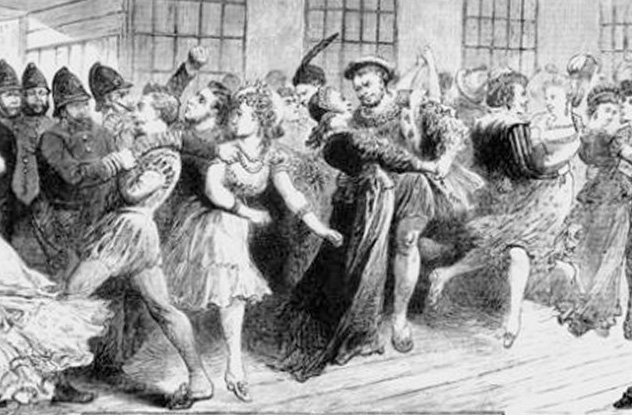
Homosexuality was frowned upon in Victorian Britain—the nation locked up one of its most prominent playwrights for practicing the “love that dare not speak its name.” Jerome Caminada was very much a product of his time and was occasionally called upon to preserve Victorian morality.
In September 1880, Caminada got word that something fishy was happening in the Hulme district of Manchester. The detective went to investigate and found a wild party going down in Temperance Hall. It was hard to see inside, as the windows were covered in black paper. Wanting a look, Caminada worked his way onto a nearby rooftop and peered down to see men in drag doing the can-can.
Convinced serious crimes were occurring, Caminada, several officers, and a handful of eager citizens made their way to the hall door. After knocking, Caminada mustered up his most feminine voice and whispered, “Sister”—he’d spied on a previous drag ball and learned the secret password to get inside. When the door opened, the police and company stormed the building and found 47 revelers. About half were dressed as women, and the others were costumed as historical characters like Henry VIII and Sir Walter Raleigh.
Caminada rounded up all the partygoers, but they didn’t stay incarcerated long. The magistrates presiding over the case were embarrassed to have an orgy going on in their fair city. When defense attorneys argued that the prosecution had little evidence, the men in white wigs were only too happy to listen. The defense argued that Caminada hadn’t actually seen any illegal activity, and no other witnesses could back his story. The musician at the hall couldn’t provide much testimony—he was blind.
Glad for a chance to avoid scandal, the judges dropped charges of conspiracy to solicit an “unnameable offence” and simply fined the young party animals and sent them on their way.
3 The Fenian Conspiracy
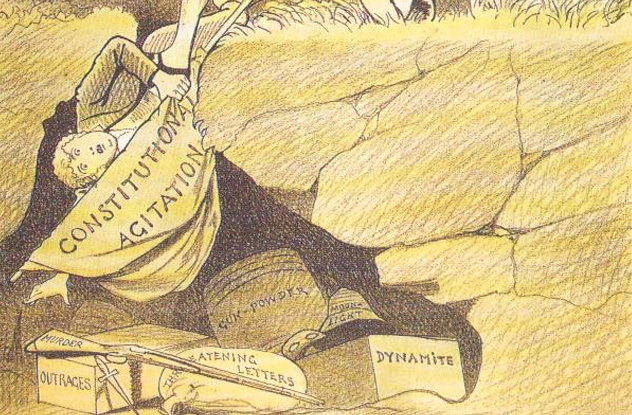
Back in the Victorian Era, England had its hands full with a group called the Fenians. Made up mostly of Irish-Americans, the Fenians united smaller organizations working together with a common goal: to bomb the English until they gave Ireland independence. In 1881, they launched their notorious dynamite campaign, attacking sites like the Tower Bridge, Scotland Yard, and the House of Commons.
As he a Roman Catholic with an Irish mother, Caminada was the perfect man to hunt the Fenians down. He doggedly pursued the terrorists for 20 years, chasing them in countries like France, Germany, and America.
He ended up in hairy situations on more than one occasion. For example, he once found himself hiding under a staircase, pistol in hand, as he spied on terrorists plotting in the next room. Another time, he actually befriended one of the Fenians, and the two struck up such a good friendship that Caminada was invited home for supper.
In one of his crazier cases, Caminada found a notebook full of ripped-out pages, but he was able to read the imprint of a French address. The detective tracked the terrorist down to Paris and was about to take the man down when he received word from the higher-ups to let him go for the time being. Disappointed, Caminada and his associates were preparing to return home when they were arrested by French authorities. The Frenchmen thought Caminada was an Irish terrorist. But as the cops discussed what they should do with Caminada and his crew, the detective slipped onto a nearby train and gave his captors the slip.
2 The Mystery Of The Four-Wheeled Cab
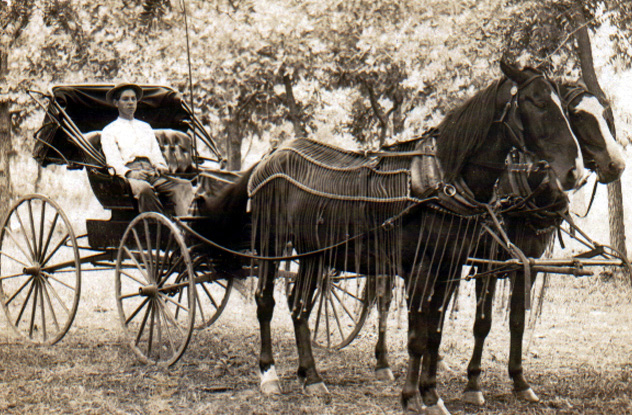
The curious case began on February 26, 1889 when a businessman named John Fletcher and a young, unidentified companion boarded a cab near Manchester Cathedral. An hour later, the driver checked on his passengers to find the young man vanished and John Fletcher dead.
It seemed Fletcher had died after a bout of serious drinking. The man was known to hit the bottle now and then, and he hadn’t been beaten or strangled. However, Fletcher was missing all of his money, and when an autopsy was ordered, the doctor found the sedative chloral hydrate in his stomach. Suddenly, it looked like the old man might have been poisoned by his fellow passenger.
Enter Caminada and his encyclopedic knowledge of poisons and chemicals. Caminada knew chloral hydrate was often used in illegal boxing matches. Cheaters used the drug to spike the water that boxers used to wash their mouths between rounds. Caminada also knew of a local character named “Pig Jack” who had a history of drugging fighters with the substance. This oddly named swindler didn’t match the cab driver’s description of the young man who’d disappeared that February night. The description did, however, match his 18-year-old son, Charles Parton.
Parton wouldn’t admit to the murder. He claimed he’d been in Liverpool on the day in question—and that turned out to be a huge mistake. Caminada discovered that someone had broken into a Liverpool pharmacy that day and stolen an entire bottle of chloral hydrate. Parton’s fate was sealed when witnesses came forward, some claiming they’d seen him spending a whole lot of money after Fletcher’s death and another describing how he’d seen Parton pouring a strange liquid into the businessman’s beer.
Caminada slapped cuffs on the young killer, and Parton was imprisoned for life. The Manchester Cab Mystery became Caminada’s most famous case, making him a national hero.
1 Caminada’s Moriarty

Every hero has their archenemy. Batman has Joker, Harry Potter has Voldemort, and Sherlock Holmes has Moriarty. Granted, this psychopathic professor only showed up in two of Doyle’s original stories, but thanks to movies, television, and fan fiction novels, we’ve come to know this crafty creature as Sherlock’s greatest foe.
Jerome Caminada had his own archenemy to deal with, a murderous thief by the name of Bob Horridge. Their rivalry began in 1870 after Caminada arrested the crook for stealing a watch. The thief had dropped the timepiece at a shop for repairs, and the detective simply waited for Horridge to pick it up. But when a judge sentenced the thief to seven years in prison, Horridge swore revenge.
Upon his release, Horridge kicked his criminal activities into full gear. He broke into shops, absconded with safes, and made his way through warehouses with utter disdain for the law. Horridge also became something of an escape artist. On several occasions, he successfully avoided arrest, once by diving into a river and once by sneaking his way through connected attics. And when he wound up in prison a second time, Horridge successfully broke out, even after guards pumped three bullets into his body.
Horridge finally went too far after he shot two officers who’d attempted to stop his latest break-in. Knowing they needed the best detective to track this punk down, authorities called for Caminada, and the bushy-bearded investigator started hunting for a scent. Eventually, he tracked Horridge’s wife to Liverpool, where he spotted Horridge from a distance, recognizing the criminal by his unique walk. Moving in for the arrest, Caminada grabbed his foe and asked, “Hello Bob, how are you?”
Horridge reached for his gun, but Caminada was faster. The detective placed his pistol against the criminal’s mouth and threatened, “If there’s any nonsense with you, you’ll get the contents of this.” The thief fought back, and the two wrestled back and forth until Caminada finally subdued his foe with the help of several assisting officers. Horridge received a life sentence for shooting two police officers and spent the rest of his days behind bars.
If you want to learn more about Jerome Caminada, check out his memoirs or read Angela Buckley’s great biography. If you want to keep up with Nolan’s writing, you can friend/follow him on Facebook or email him here.








